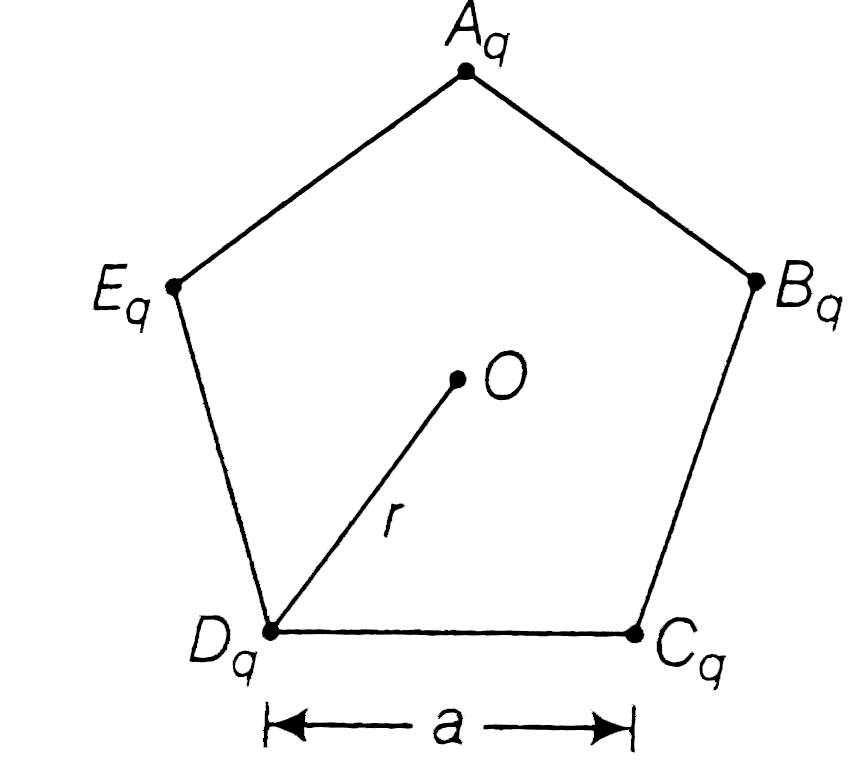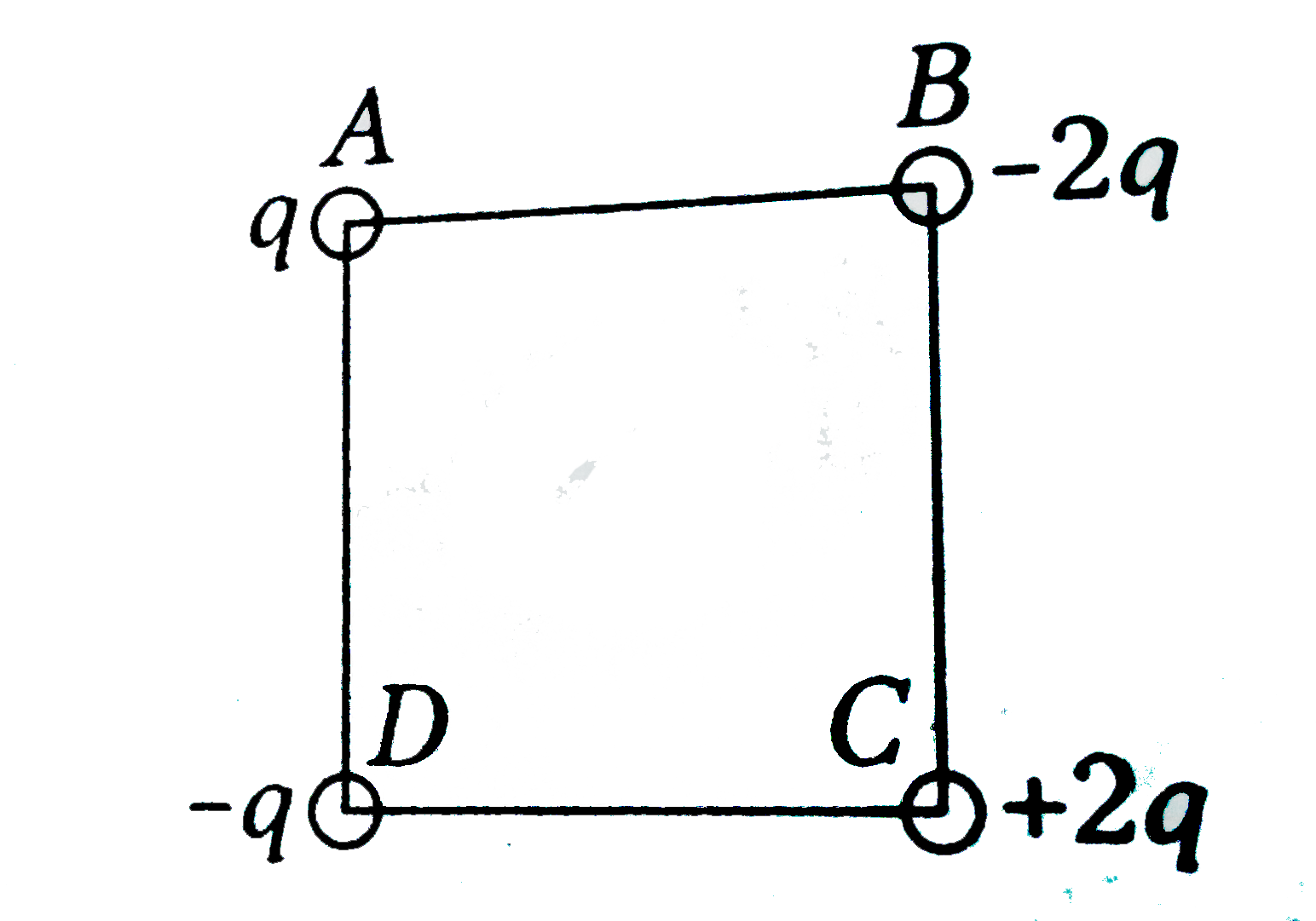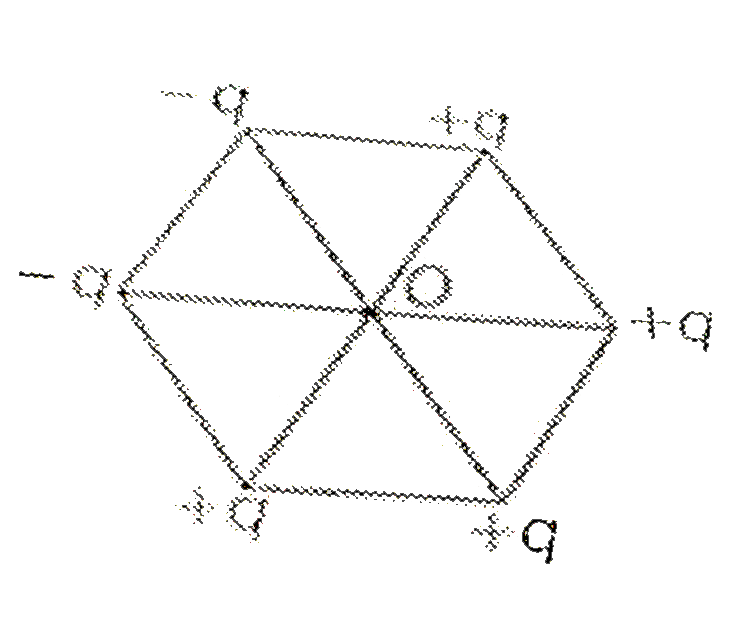Five charges, q each are placed at the corners of a regular pentagon of side a. (Refer the adjoining figure)
(a) (i) What will be the electric field at O, if the centre of the pentagon?
(ii) What will be the electric field at O if the charge from one of the corners (say A) is removed?
(iii) What will be the electric field at O if the charge q at A is replaced by -q?
(b) How would your answer to (a) be affected if pentagon is replaced by n-sided regular polygon with charge q at each of its corners?

(a) (i) The magnitude of the electric field intensity at the centre of the pentagon is the same for all the charges, and all these five electric field vectors are directed away from each corner of the pentagon towards the centre. These electric field vectors will make a 72∘ angle with the electric field of its adjacent particle. If we arrange all the five vectors in an order such that the tail of one is placed on the head of the other, then we can see that the polygon will get completed and the resultant will become zero.
(ii)The resultant of all five vectors is zero, hence we can say that the resultant of any four of them will be equal and opposite to the electric field intensity of the fifth particle. If the charged particle at A is removed, then the net electric field intensity at point O will be directed from point O towards point A with the same magnitude as due to the particle at point A. Hence the electric field intensity at the centre becomes q4πε0r2 from point O towards point A.
(iii) If the charge at point A is replaced by another -q charge, then the electric field of-q charge will also be added in the same direction along OA to make the resultant two times the value mentioned above in (ii), hence the electric field will be 2q4πε0r2 from point O towards point A.
(b)The answers will not be affected if it were any other regular polygon instead of a pentagon.
Topper's Solved these Questions
- ELECTRIC CHARGES AND FIELDS BOOK - MODERN PUBLICATIONCHAPTER - ELECTRIC CHARGES AND FIELDS EXERCISE - Higher Order Thinking Skills & Advanced Level (Questions With Answers)
5 Videos
- ELECTRIC CHARGES AND FIELDS BOOK - MODERN PUBLICATIONCHAPTER - ELECTRIC CHARGES AND FIELDS EXERCISE - Revision Exercises (Very short)
55 Videos
- ELECTRIC CHARGES AND FIELDS BOOK - MODERN PUBLICATIONCHAPTER - ELECTRIC CHARGES AND FIELDS EXERCISE - Ncert File (Textbook Exercise)
34 Videos
- DUAL NATURE OF RADIATION AND MATTER BOOK - MODERN PUBLICATIONCHAPTER - DUAL NATURE OF RADIATION AND MATTER EXERCISE - CHAPTER PRACTICE TEST
15 Videos
- ELECTROMAGNETIC INDUCTIONBOOK - MODERN PUBLICATIONCHAPTER - ELECTROMAGNETIC INDUCTIONEXERCISE - CHAPTER PRACTICE TEST FOR BOARD EXAMINATION
14 Videos
Similar Questions
Five charges, q each are placed at the corners of a regular pentagon of side a. (Refer the adjoining figure)
(a) (i) What will be the electric field at O, if the centre of the pentagon?
(ii) What will be the electric field at O if the charge from one of the corners (say A) is removed?
(iii) What will be the electric field at O if the charge q at A is replaced by -q?
(b) How would your answer to (a) be affected if pentagon is replaced by n-sided regular polygon with charge q at each of its corners?

View SolutionFive charges , q each are placed at the corners of a regular pentagon of side.

(a) (i) What will be the electric field at 0, the centre of the pentagon?
(ii) What will be the electric field at 0 if the charge from one of the corners (say A) is removed?
(iii). What will be the electric field at 0 if the pentagon is replaced by n-sided regular polygon with charge q at each of its corner?
View Solution
Knowledge Check
In question number 45, what will be the electric field at O if the charge q at A is replaced by -q?
Aq4πε0r2 along OBB2q4πε0r2 along OAC4q4πε0r2 along OCDzeroIn question number 45, what will be the electric field at centre O, if the charge from one of the corners (say A) is removed?
Aq4πε0r2 along OAB2q4πε0r2 along OBCq24πε0r2 along OCD2q4πε0r2 along OAFive point charge (+q each) are placed at the five vertices of a regular hexagon of side 2a.what is the magnitude of the net electric field at the centre of the hexazon?
A14πε0qa2Bq16πε0a2C√2q4πε0a2D5q16πε0a2
Five equal charges each of value q are placed at the corners of a regular pentagon of side a. The electric field at the centre of the pentagon is

View SolutionFour charges are placed at the corners of a square of side 10 cm as shown in figure. If q is 1μC, then what will be electric field intensity at the centre of the square?

View SolutionSix point charges are arrange at the vertices of a regular hexagon of side length a (shown in figure).

Find the magnitude of electric field at the centre of regular hexagon.
View SolutionFive point charge (+q each) are placed at the five vertices of a regular hexagon of side 2a.what is the magnitude of the net electric field at the centre of the hexazon?
View SolutionFive identical point charges +Q are placed at the five corners of a regular hexagon of edge length a. One corner is empty. Electric field intensity at the centre of the hexagon is
View Solution
